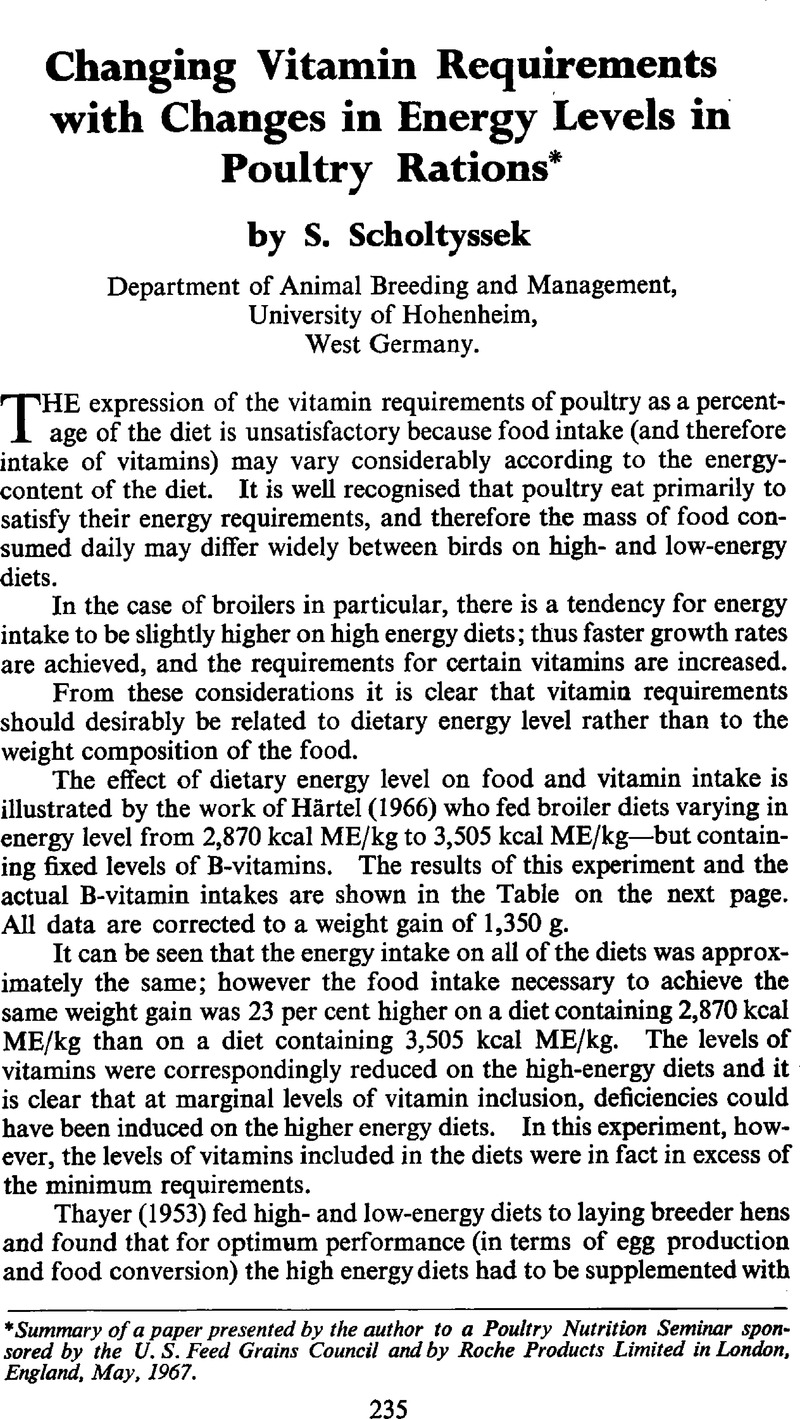No CrossRef data available.
Article contents
Changing Vitamin Requirements with Changes in Energy Levels in Poultry*
Published online by Cambridge University Press: 18 September 2007
Abstract
An abstract is not available for this content so a preview has been provided. Please use the Get access link above for information on how to access this content.

- Type
- Research Article
- Information
- Copyright
- Copyright © Cambridge University Press 1969
References
Bro-Rasmussen, F. (1958). The Riboflavin Requirements of Animals and Man and Associated Metabolic Relations. Part II: Relation of Requirement to the Metabolism of Protein and Energy. Nutrition Abstracts and Reviews. 28: 369–386.Google Scholar
Chu, A. B., Potter, L. M., Applegate, B. K., and Leighton, A. T. (1964). Influence of Increasing Dietary Energy on the Riboflavin Requirement of Young Turkeys. Poultry Science. 43: 1307.Google Scholar
Day, E. J., and Dilworth, B. C. (1966). Effects of Supplementing Laying Rations with certain B-complex Vitamins. British Poultry Science 7: 99.CrossRefGoogle ScholarPubMed
Ferrando, R., and Mainguy, P. (1962). Influence du taux de protides et de lipides totaux de la ration surla resérve hépatique de vitamine A chezlepoulet. 12th World's Poultry Congress, Sydney, 1962, Section papers p. 168.Google Scholar
Friesecke, H., and Kirchgessner, M. (1963). Zur Vitamin B6-Versorgung von Küken and Hennen. Archiv F. Geflügelkunde. 27: 296.Google Scholar
Hartel, H. (1966). Untersuchungen über den Futterwert von Broilerrationen in Abhāngigkeit vom Eiweiss: Energierverhāltnis und von der Energiekonzentration. Dissertation Hohenheim.Google Scholar
Lockhart, W. C., Bryant, R. L., and Bolin, D. W. (1966). The effects of B-Vitamin Deprivation on Subsequent Energy Metabolism. Poultry Science. 45: 520.CrossRefGoogle Scholar
March, B., and Biely, J. (1953). The Effect of Ascorbic Acid on the Growth Rate of Chicks. Poultry Science. 32: 768.CrossRefGoogle Scholar
Scott, M. L. (1966). Factors Modifying the Practical Vitamin Requirements of Poultry, Proc. Cornell Nutrition Conference Feed Manuf. p.35.Google Scholar
Shellenberger, T. E., Parrish, D. B., and Sanford, P. E. (1960). Effect of Vitamin A Level of Diet on Feed Conversion and Utilisation of Energy by Growing Chickens. Poultry Science. 39: 1413.CrossRefGoogle Scholar
Thayer, R. H. (1953). Vitamin Levels in High Energy Layer-Breeder Rations. Poultry Science. 32, 927.Google Scholar
Thornton, P. A., and Shutze, J. V. (1960). The Influence of Dietary Energy Level, Energy Source and Breed on the Thiamine requirement of Chicks. Poultry Science. 39: 192.CrossRefGoogle Scholar
Scholtyssek, S., and Haussermann, W. (1963). Zusammenhänge zwischen Calcium-Stoffwechsel (45Ca) und Legeleistung von Käfighennen bei unterschiedlichem Temperatur-und Vitamin C-Angebot. Archiv F. Geflügelkunde. 27: 5.Google Scholar




